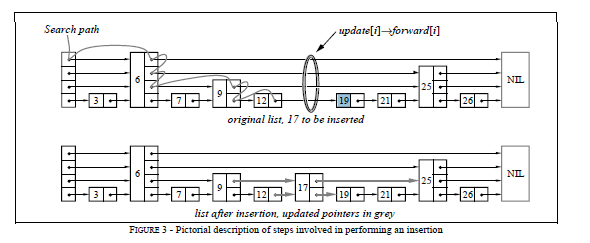skiplist思想可以具体参考这:
或者是参考我的这篇博文:http://www.cnblogs.com/xuqiang/archive/2011/05/22/2053516.html, leveldb中的实现方式基本上和我的那篇博文中的实现方式类似。SkipList在db/skiplist.h中声明,向外界暴漏接口非常简单,如下:
// Create a new SkipList object that will use "cmp" for comparing keys,
// and will allocate memory using "*arena". Objects allocated in the arena
// must remain allocated for the lifetime of the skiplist object.
explicit SkipList(Comparator cmp, Arena* arena);
// Insert key into the list.
// REQUIRES: nothing that compares equal to key is currently in the list.
void Insert(const Key& key);
// Returns true iff an entry that compares equal to key is in the list.
bool Contains(const Key& key) const;private成员变量:
// 最大的level
enum { kMaxHeight = 12 };
// Immutable after construction
Comparator const compare_;
// 内存分配器
Arena* const arena_; // Arena used for allocations of nodes
// 指向第一个节点,构造函数中初始化
Node* const head_;
// Modified only by Insert(). Read racily by readers, but stale
// values are ok.
port::AtomicPointer max_height_; // Height of the entire list// 初始化:
// 1. 初始化compare_
// 2. 初始化arena_
// 3. 初始化head_,指向指针数组
// 4. 初始化max_height_
// 5. 初始化rnd_随机数的seed
// 6. 初始化head_指向的数组
template<typename Key, class Comparator>
SkipList<Key,Comparator>::SkipList(Comparator cmp, Arena* arena)
: compare_(cmp),
arena_(arena),
head_(NewNode(0 /* any key will do */, kMaxHeight)),
max_height_(reinterpret_cast<void*>(1)),
rnd_(0xdeadbeef) {
// 初始化head_指向的数组
for (int i = 0; i < kMaxHeight; i++) {
head_->SetNext(i, NULL);
}
}下面是一个插入操作的示意图:

leveldb中实现的插入代码就是按照上面的思路实现,首先查找到合适的位置,并记录查找过程中经过的路径,之后新生成一个节点,修改指针。
// 插入操作
// 这里的key其实已经是经过处理的key,包含了用户指定的key和value
template<typename Key, class Comparator>
void SkipList<Key,Comparator>::Insert(const Key& key) {
// TODO(opt): We can use a barrier-free variant of FindGreaterOrEqual()
// here since Insert() is externally synchronized.
// prev记录的是查询路径,下面需要使用prev来修改新生成
// 节点的指针
Node* prev[kMaxHeight];
Node* x = FindGreaterOrEqual(key, prev);
// Our data structure does not allow duplicate insertion
// 不允许插入重复的值
assert(x == NULL || !Equal(key, x->key));
// 随即生成节点高度
int height = RandomHeight();
// 对prev数组中未赋值的元素进行赋值
if (height > GetMaxHeight()) {
for (int i = GetMaxHeight(); i < height; i++) {
prev[i] = head_;
}
// It is ok to mutate max_height_ without any synchronization
// with concurrent readers. A concurrent reader that observes
// the new value of max_height_ will see either the old value of
// new level pointers from head_ (NULL), or a new value set in
// the loop below. In the former case the reader will
// immediately drop to the next level since NULL sorts after all
// keys. In the latter case the reader will use the new node.
// 设置max_height变量
max_height_.NoBarrier_Store(reinterpret_cast<void*>(height));
}
// 新生成一个节点,之后插入数据
x = NewNode(key, height);
for (int i = 0; i < height; i++) {
// NoBarrier_SetNext() suffices since we will add a barrier when
// we publish a pointer to "x" in prev[i].
// 修改两部分的指针,一部分是需要执行新插入节点的指针
// 另外的一部分是x节点的指针
x->NoBarrier_SetNext(i, prev[i]->NoBarrier_Next(i));
prev[i]->SetNext(i, x);
}
}函数FindGreaterOrEqual中完成查询操作,就是向下(level控制)和向右(x控制)移动过程,并不断经经过路径保存到参数prev中。
template<typename Key, class Comparator>
typename SkipList<Key,Comparator>::Node*
SkipList<Key,Comparator>::FindGreaterOrEqual(const Key& key,
Node** prev)
const {
// 从最高层开始查找
Node* x = head_;
int level = GetMaxHeight() - 1;
while (true) {
Node* next = x->Next(level);
if (KeyIsAfterNode(key, next)) { // 向右移动
// Keep searching in this list
x = next;
}
else // 向下移动
{
// 记录查找路径
if (prev != NULL)
prev[level] = x;
if (level == 0) {
return next;
} else {
// Switch to next list下一层寻找
level--;
}
}
}
}查找操作基本上就是调用函数上面的函数FindGreaterOrEqual实现:
// 查询操作
template<typename Key, class Comparator>
bool SkipList<Key,Comparator>::Contains(const Key& key) const {
Node* x = FindGreaterOrEqual(key, NULL);
if (x != NULL && Equal(key, x->key)) {
return true;
} else {
return false;
}
}上面基本上就是skiplist在leveldb中实现,leveldb中没有使用复杂的红黑树等机制去保证数据的有序性,而是使用了轻快的skiplist实现。最后需要注意skiplist中每个节点存储key是用户传递keyvalue经过变幻(变幻方法参考http://blog.csdn.net/xuqianghit/article/details/6948164)得到的。







 本文深入分析了leveldb中SkipList数据结构的实现细节,包括初始化、插入、查找和核心思想。重点阐述了如何利用随机高度的链表节点实现高效的数据存储与检索。
本文深入分析了leveldb中SkipList数据结构的实现细节,包括初始化、插入、查找和核心思想。重点阐述了如何利用随机高度的链表节点实现高效的数据存储与检索。
















 560
560

 被折叠的 条评论
为什么被折叠?
被折叠的 条评论
为什么被折叠?








